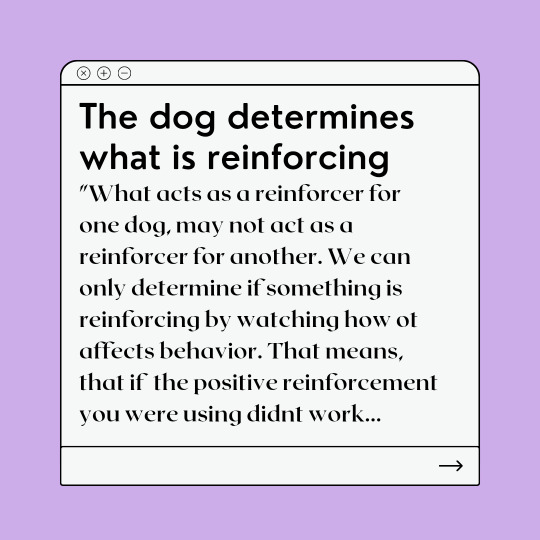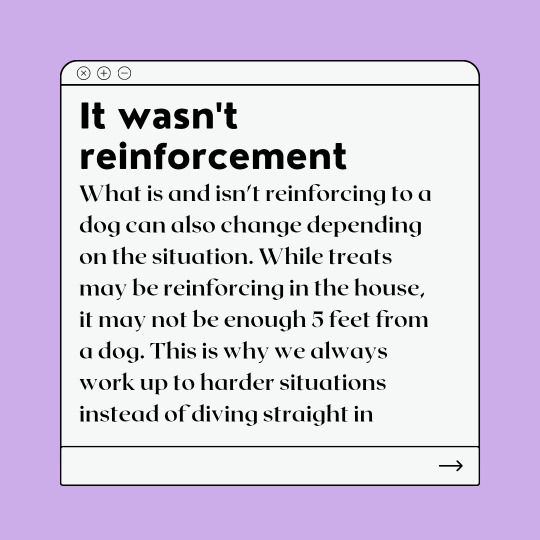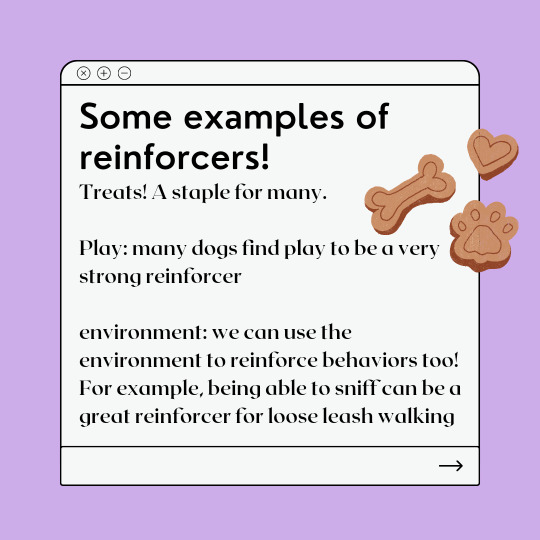All things Force Free Dog Training. IAABC- Accredited Dog Training, Fear free shelters certified, Pet Professional Guild- Professional Member. Consistently working on continuing education
Don't wanna be here? Send us removal request.
Text
"positive reinforcement failed this dog! so they came to me and I successfully rehabbed this terribly fear aggressive dog!" said by a trainer that literally did not solve a problem but rather shut down a dog by over exposing it to fear.
81 notes
·
View notes
Text
A quick little look at some body language that was misinterpreted by a trainer
#dog trainer#dogtraining#forcefree#force free dog training#dog training#positive reinforcement#positive reinforcement dog training
1 note
·
View note
Text
I love this so much. R+ is just as important for the people we work with.
I'm still having kind of a rough time personally, but I got a compliment at work that was so nice it almost makes everything okay.
It was my off leash agility 1 class. And at the end I was telling them how impressed I was since the dog recently completed the intro class and this was only their second time working off leash. And they told me
"At the previous place we trained we were always wrong and she was always a bad dog. Here, you're always saying we're right and that she's a good dog. We never thought she could be engaged and off leash let alone doing amazing things like flying over jumps. But she loves it and it's like you've given us permission to love her."
Y'all I almost bawled on the spot.
This is what drives me to teach agility. I absolutely love showing people how amazing their dogs are and helping them build a relationship centered on having fun together as a team.
26 notes
·
View notes
Text
Have compassion for your force-free dog trainers around. Constantly fighting for ethical training is an exhausting endeavor.
#being force free means constantly being accused of getting dogs euthanized#and being innefective#when really we are achieving results without using pain compulsion or fear#force free#forcefree#its exhausting having to battle people and push for ethical training constantly
4 notes
·
View notes
Text
I prefer the PPGs pet dog ambassador program over the CGC generally!
i really dislike the "supervised separation" component of the CGC test bc its such a useless measurement. its supposed to show that your dog doesn't have separation anxiety and can remain calm and collected when you leave them, yes i get that. and i agree that it's an important skill to learn! but the way its measured in the actual CGC test is so dumb (you give your dogs leash to someone and walk out of sight for 3 minutes, the person holding the dog stands still for 3 minutes and does not engage with the dog).
like, boone has separation anxiety. had it his whole life, minimal improvement, he will cry and hyperventilate and panic if he gets left home alone. but he could absolutely pass this part of the CGC, because if i hand him to someone else he will just quietly stand there and wait.
stellina does not have separation anxiety, but she fails this part of the CGC because she doesn't like standing still doing nothing, and will start to get vocal unless someone starts engaging with her or starts walking somewhere or kennels her.
but by CGC standards, she is the one who gets labeled as having separation anxiety, and not boone. even though the act of me leaving isn't her issue - if i stood there ignoring her for several minutes she'd do the same thing. and also, when am i ever going to be in this situation? at what time do i need to give my dog to someone to stand there and hold and completely ignore her? its such a weird forced situation and i wish it would be either changed to make it more applicable or just removed.
(im totally not just bitching because im bad at dog training and cant pass this one last part)
126 notes
·
View notes
Text
Meet Billy! Billy is a 12 year old rescue pup, who has some big feelings about other dogs, and isn't so sure how he feels about having his collar and harness taken off. He has two wonderful pawrents who are super excited to learn how to help him manage his fears! They are learning how to read his body language, and help him have some more positive feelings about other dogs. They're also working on cooperative care with him, so that he can feel more comfortable with his gear!

#dogtrainer#dog training#force free#+r#force free dog training#dog trainer#forcefree#positive reinforcement#r+#cooperative care#desensitization#counter conditioning#reactivity#reactivity training
1 note
·
View note
Note
So I was wondering, what is so wrong with Cesar Millans training techniques? For some reason all of tumblr seems to hate him, and I can't, for the life of me, figure out why? His techniques work. He doesn't hit the dogs, I don't see obvious abuse.. So help me out here. What's so wrong?
First of all. Yes he does hit dogs. And kicks them. And don’t tell me he doesn’t because he does. You can skirt around it using buzz words like “touch” and “energy” but it’s a hit. It’s positive punishment - applying an aversive to suppress behaviour, especially aggressive behaviour, which is often caused by anxiety. And it’s not okay. It is abusive.
The Five Freedoms of Animal Welfare stipulate that animals must be free from pain and fear. Cesar Millan’s techniques, especially with aggressive dogs, rely on aversives, which cause pain and discomfort and stress. And that’s not okay.
His methods are highly aversive and can exacerbate or even cause aggression. They revolve around intimidation, pain and coercion and are highly stressful for dogs. They result in shut-down, miserable dogs often with chronic stress.
The highest frequency of aggression occurred in response to aversive (or punishing) interventions, even when the intervention was indirect:
• Hitting or kicking the dog (41% of owners reported aggression)• Growling at the dog (41%)• Forcing the dog to release an item from its mouth (38%)• “Alpha roll” (forcing the dog onto its back and holding it down) (31%)• “Dominance down” (forcing the dog onto its side) (29%)• Grabbing the jowls or scruff (26%)• Staring the dog down (staring at the dog until it looks away) (30%)• Spraying the dog with water pistol or spray bottle (20%)• Yelling “no” (15%)• Forced exposure (forcibly exposing the dog to a stimulus – such as tile floors, noise or people – that frightens the dog) (12%)
In contrast, non-aversive methods resulted in much lower frequency of aggressive responses:
• Training the dog to sit for everything it wants (only 2% of owners reported aggression)• Rewarding the dog for eye contact (2%)• Food exchange for an item in its mouth instead of forcing the item out (6%)• Rewarding the dog for “watch me” (0%)
(source) (CM uses 1, 3, 4, 5, 6, 7, a version of 9, and 10 extensively. (x)
Also:
He employs an archaic ideology that all misbehaviour is caused by dogs trying to assert their dominance. Which is WRONG, WRONG, WRONG. This crap has been disproved countless times. Dogs are not trying to achieve world domination jfc
His methods have been condemned by veterinary behaviourists, animal behaviourists and animal welfare groups.
He sets the dogs off deliberately for the show. Seriously. He sets them up for failure and then punishes them for reacting. That’s not ethical and it compromises welfare.
Here’s some handy dandy links for you to read because I have gone over this so many times and I feel like a broken record at this point:
Up to date information on wolf pack structure by top wolf biologist L. David Mech:
Alpha Status, Dominance, and Division of Labor in Wolf Packs
Whatever Happened to the Term Alpha Wolf?
Information on dog training and dog behavior and why Cesar’s methods are outdated and ineffective (many of these articles are by vets and certified animal behaviorists) :
Cesar Millan, Dominance Theory and Modern Dog Training
The Dog Whisperer Controversy
The Dog Whisperer: Frequently Asked Questions
Modern Dog Training vs. Cesar Millan
The Dominance Controversy and Cesar Millan
From Andrew Luescher, DVM, Veterinary Behaviorist
Veterinary Behaviorists Take a Stand Against Cesar Millan
dog training gone bad - Debra F. Horwitz, DVM, DACVB
I’m not sure why people are even trying to defend Cesar Millan on that slide for my animal welfare presentation(which got really popular wowie did not expect that). I explain very clearly what learned helplessness is. I put a picture of a dog in a state of shut-down with Millan leaning over it and grinning like it’s the best thing ever. And people are still defending him and don’t see an issue with it. Take off those blinkers and look.
4K notes
·
View notes
Text







We often hear people say that positive reinforcement doesn't work for them, or doesn't work for certain breeds of dogs.
Oftentimes this is due to a fundamental misunderstanding of reinforcement. It tends to be thought of as something particular. I.e treats are reinforcers. And yes, often they are. But a reinforcer is anything that increases (or maintains) the rate of a behavior, if it doesn't, it isn't a reinforcer! Reinforcers are determined based on their effect. We don't get to decide what is, and isn't one, that's up to the learner!
#dog trainer#positive reinforcement#force free dog training#force free#dog training#dog#doggo#r+#+r#fear free#forcefree#dogs deserve to be understood
1 note
·
View note
Text
This is the power of cooperative care!
Maple's first cooperative care blood draw! She did great!!
Trained entirely with choice-based positive reinforcement training :)
51 notes
·
View notes
Text

I think it's really important to remember that many of the behaviors that we see as "problematic" are perfectly natural behaviors for dogs, and that many of the things that we ask them to do such as walking in a straight line beside us are unnatural and hard asks for them! This is why it's so important to take the time to teach dogs what we are asking for with compassion, and remember that while these tasks may seem simple to us, they are a lot for them! In addition to this, when training a new behavior to replace natural behaviors, that we give them other ways to fulfill that need or better yet, come to a compromise that works for both.
For example when teaching a loose leash walk, I want the dog to keep the leash loose, and I don't want them stepping right in front of my feet (for safety), but I'm happy to have them sniff plenty, walk ahead of me, and cross sides safely. I tailor my criteria to teach this so that I can walk comfortably, their joints are kept safe, and they still get to do all of those doggy things!
#Force free dog training#Force free#forcefree#Positive reinforcement#R+#+R#Reinforcement#Science based training#Wellness based training#dog training#dog trainer
9 notes
·
View notes
Text
Students standing up to leave at the sound of the school bell is a conditioned response. They have learned that when that bell rings, they are able to leave the classroom and have some free time, which is very reinforcing for most students. This response ends up backfiring on the teacher if they need the students to stay a few minutes late. That conditioned response is so strong that the students will struggle to stay seated and calm. They will also struggle to learn during that time, because they are using a lot of mental energy to fight the conditioned response.
Conditioned responses can be changed. One way is by providing an even stronger reinforcer. If the class is playing a fun game and the bell rings before they can finish, students are much more likely to stay behind and ignore the bell in order to continue playing the game. In a different scenario, teacher could tell the class that they will pass out candy as soon as the lesson is finished as a reward for remaining after class. The students that like candy stay behind in order to get that reward.
Alternately, the teacher could use a form of punishment. What do you think the students would do if, as soon as the bell rings, the teacher tells them that any student who does not remain to finish the lesson will get extra homework that evening? Some students will decide that they do not want the extra homework and stay seated. This group of students will likely still struggle to stay still and on task during this time, because the desire to leave is still there—they’re too focused on listening for the OK to leave to learn! For other students, this threat may not outweigh the reinforcement of leaving at all. They hardly even consider the extra homework because they do strongly want to leave. Later when they actually have to complete the punishment homework, how do you think they are feeling? Odds are, they’re cursing the teacher for assigning the homework, rather than themselves for leaving early and earning extra homework as a consequence. This emotional response can actually increase the students’ desire to leave at the bell in order to get away from the mean teacher that assigns extra homework.
Punishment CAN work; however, because it teaches the learner what NOT to do rather than what they SHOULD do, it is much more likely to increase different behaviors or cause new behaviors to be selected in response, which are not always beneficial to the teacher. While studies are still being done on the negatives and fallouts of using positive punishment, one thing is for sure: positive reinforcement, when used correctly, is incredibly effective at changing the underlying emotions behind conditioned responses. The students who were reinforced saw staying after the bell as fun! The students who were punished still see staying after the bell as boring or undesirable, but they learned that leaving at the bell (when risk of a punisher is present) is even worse.
10 notes
·
View notes
Text
This is what many people miss in positive reinforcement training. we aren't just training away a behavior. We are changing the emotions behind the behavior. We aren't just teaching them to to react, we are teaching them that they don't need to.
A reminder that if you see a dog trainer online who claims that “positive reinforcement failed this dog” in regards to a reactive dog and then they proceed to show you how they were able to “fix” the dog’s reactivity with aversive training that:
- you don’t know how much time and effort was put towards counter conditioning the dog with positive reinforcement. Positive reinforcement counter condition to reactivity triggers takes a LONG TIME and many casual dog owners simply do not put in the work and want results ~now~.
- you don’t see the “fixed” reactive dog outside of videos in very controlled environments. The dog may still react when placed in the hands of others because the dog may be behaviorally shut down by the aversive trainer and trying to not endure any more pain then necessary. This does not “fix” reactivity. The things that trigger the dog to react still exist as a negative to trigger the dog.
- dog training is NOT a quick fix. All good dog training takes time, patience and effort. A single board and train will not fix your dog. A single class will not fix your dog. A single trainer will not fix your dog unless the work is being put in to reducing the dog’s stress and their ability to succeed EVERY. SINGLE. DAY.
575 notes
·
View notes